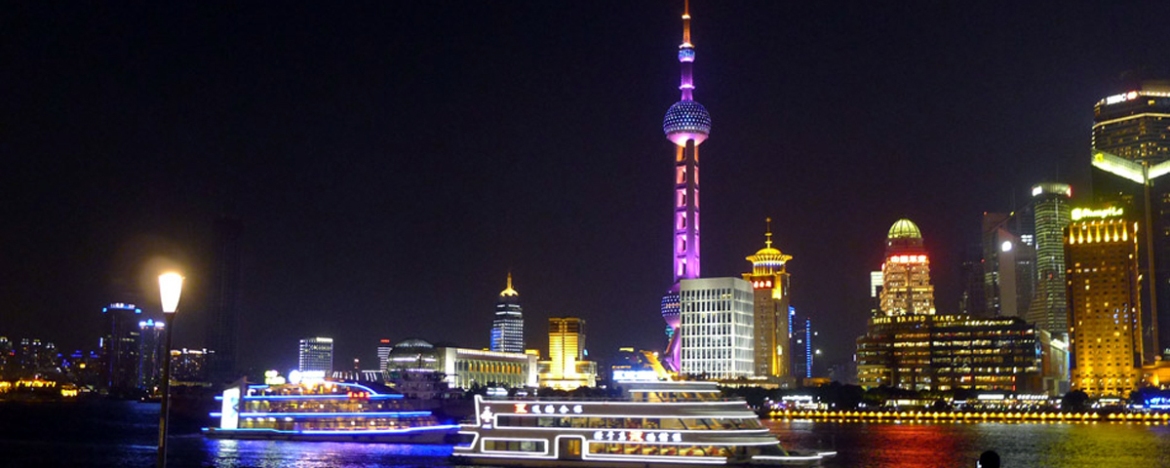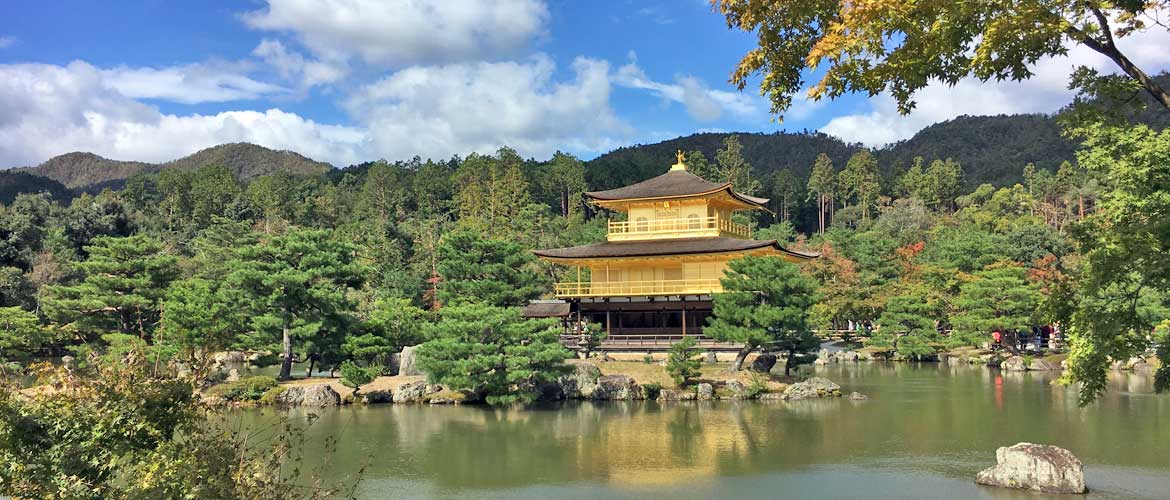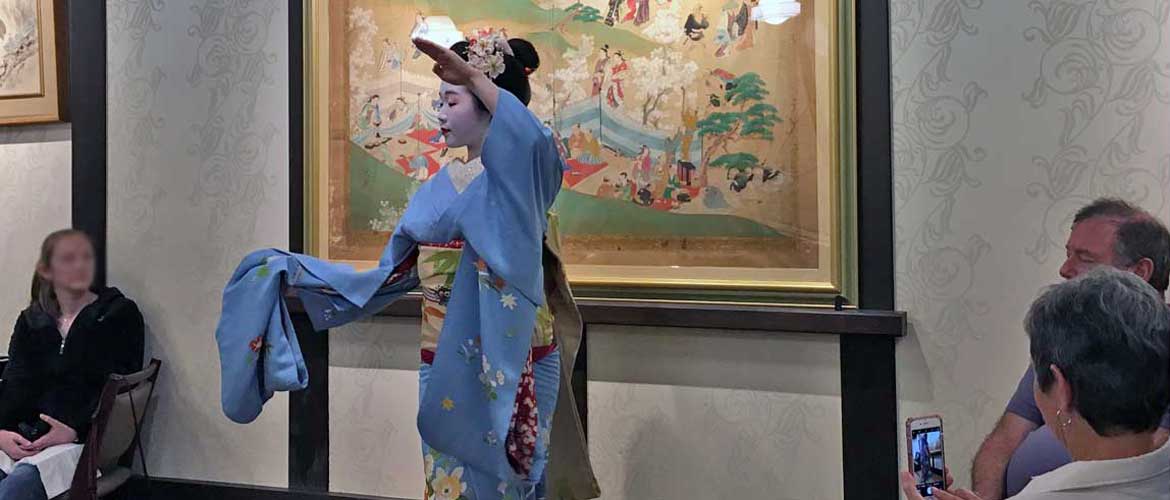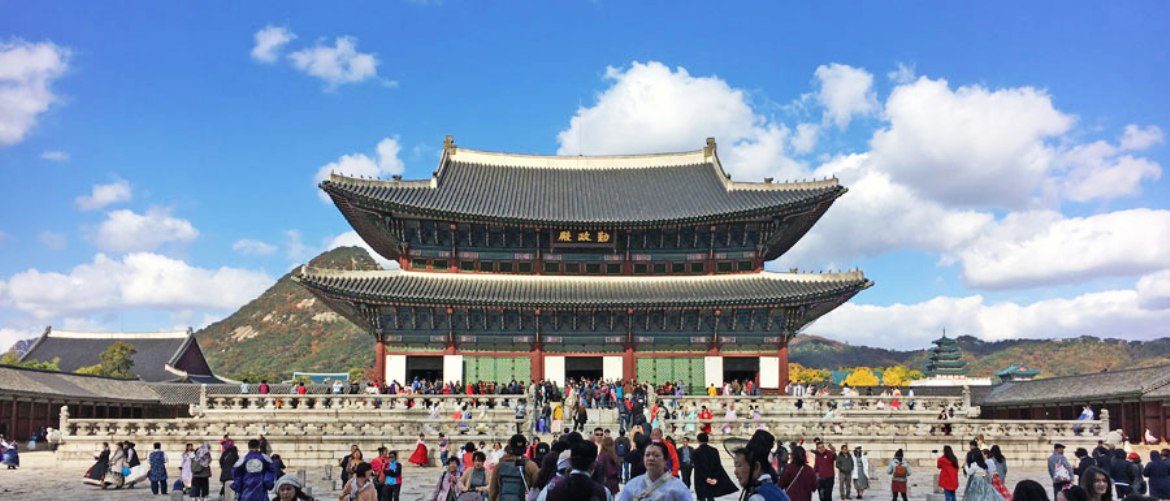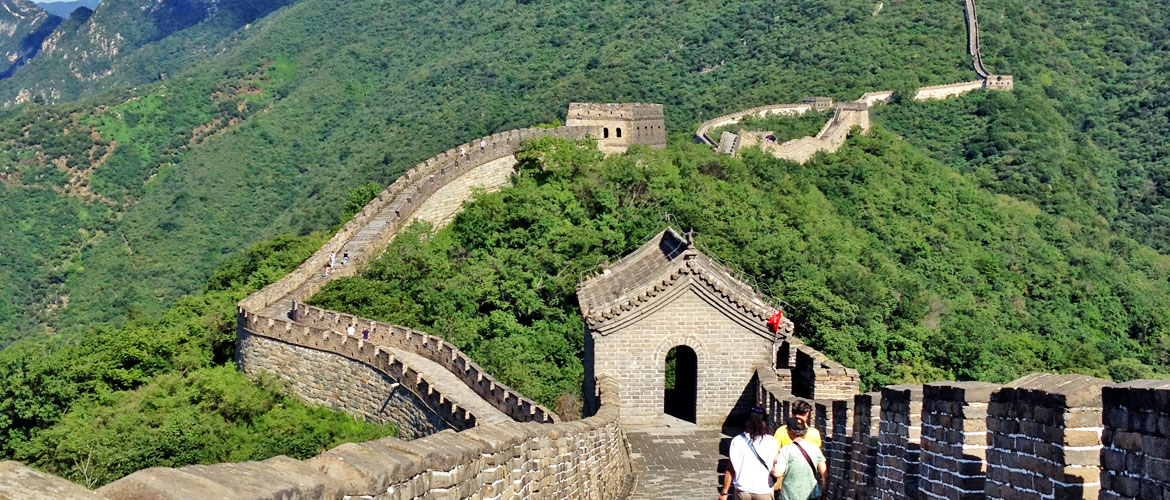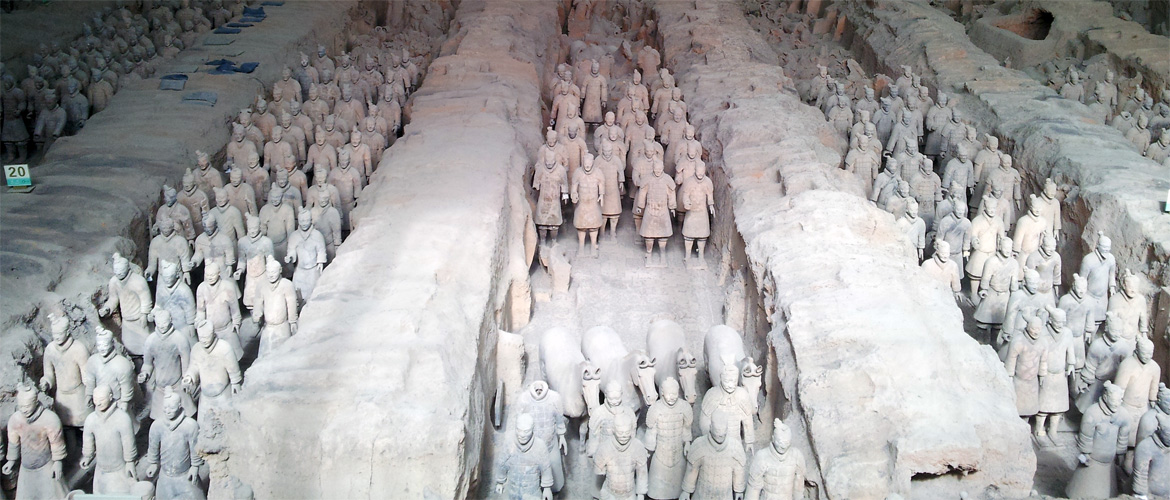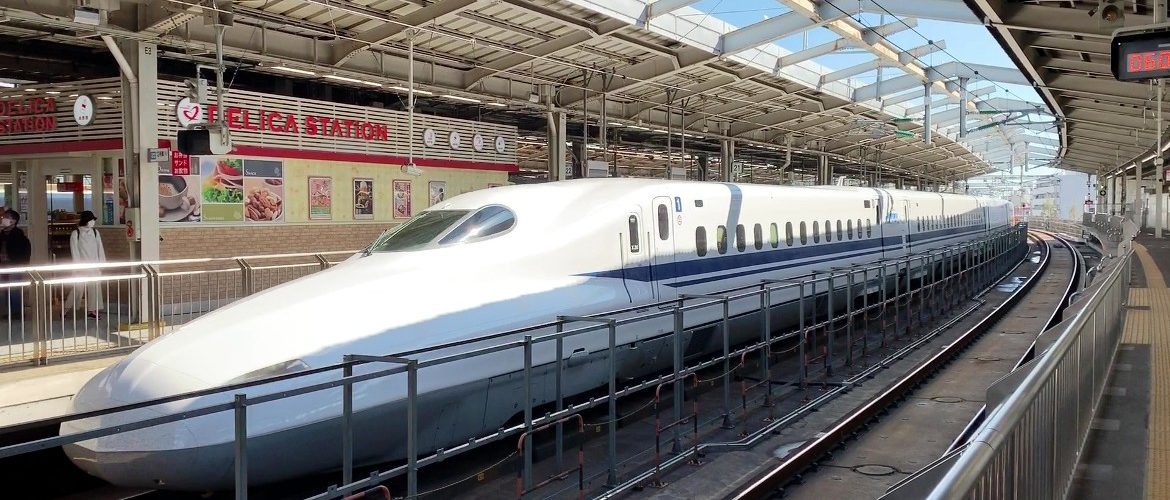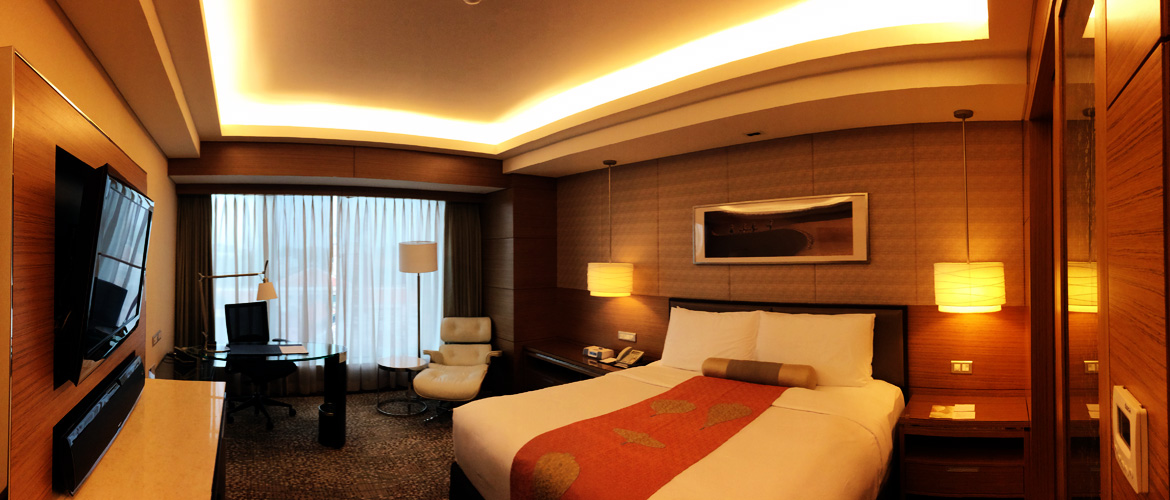Tokyo – Mt. Fuji – Hakone – Kanazawa – Shirakawa-go – Takayama – Kyoto – Nara – Osaka – Hiroshima – Miyajima – Nagasaki – Busan – Gyeongju – Seoul – Beijing – Xi’an – Chengdu – Shanghai
Designed by East Asia travel experts based on decades of personal experiences, this grand tour of Japan, South Korea and China is your ultimate East Asia adventure. Our unrivalled expertise, expert guides, and meticulous attention to detail ensure that every moment of your journey is filled with discovery and delight. Immerse yourself in the wonders of Japan, South Korea and China with a travel partner committed to turning your dreams into reality.
Important Features
- Exceptional guides handpicked by company owners.
- Small group size (20 maximum).
- Premium accommodations.
- Quality local & Western cuisines.
- No forced shopping stops of any kind.
- Immersive cultural events per itinerary.
Meal Code: B = breakfast / L = lunch / D = dinner
Day 1/Mon: Departing Home City
The journey begins with your transpacific flight departing from a city of your choice. You’ll lose a day upon crossing the International Date Line.
Day 2/Tue: Arrival in Tokyo
Welcome to Tokyo!
Please make your way to the hotel on your own. Detailed up-to-date information on how to get to the hotel will be provided in the final update two weeks before departure. Private transfer can be arranged on request.
Day 3/Wed: Tokyo (B/L)
Tokyo, literally meaning “eastern capital” and officially named Tokyo Metropolis, is one of the most populous mega-cities in the world with a population of 14 million. Formerly known as Edo, the city has been the de facto seat of the Japanese government since 1603 when shogun Tokugawa Ieyasu chose the city for his headquarters. The shogun (general) was a hereditary commander ceremoniously appointed by the emperor but held real power over the country during the shogunate period between 1192 and 1867. Edo was renamed Tokyo after Emperor Meiji moved his seat from Kyoto in 1868 when the last shogun was forced to return power to the imperial court. The city covers an area of 2,187 square kilometres following the merger in 1943 of the city of Tokyo and Tokyo Prefecture.
Our full-day sightseeing begins at the plaza in front of the Imperial Palace. The palace is closed to tourists but a stroll across the plaza accompanied by commentaries on the imperial family and the city of Tokyo gets the tour off to a good start.
We then proceed to Senso-ji, the oldest Buddhist temple in Tokyo dating back to 628.
After lunch, we drive through the ritzy Ginza shopping district on the way to Meiji Jingu, a Shinto shrine dedicated to Emperor Meiji (1852 -1912) and his wife.
We end the day with a visit to the observation deck atop the Tokyo Metropolitan Government Building in Shinjuku. On a clear day, the visitor could see the peak of Mount Fuji about 84 km to the west. The building complex completed in 1990 at a cost of US$1 billion consists of three main structures each taking up a city block. The architect of the Tokyo Metropolitan Government Building is Kenzo Tange (1913 – 2005), who in 1987 became the first Japanese to win the Pritzker Prize for Architecture.
Day 4/Thu: Tokyo – Mt. Fuji – Hakone – Tokyo (B/L)
We depart at 7:30 AM for a full-day excursion to Mt Fuji and Hakone.
Mt. Fuji, the highest mountain (3,776 metres) in Japan, is a two-hour drive from Tokyo. We stop by the Fujisan World Heritage Center to view the summit and learn about the history, formation and ecology of Mt. Fuji through exhibits and a short film. However, it is purely a matter of luck whether the summit is visible as Mt. Fuji is often shrouded in clouds. Our schedule does not include hiking the mountain – the trails are open between July and early September and it would take the average person at least six hours to hike to the summit even if one starts from the highest station at 2,305 metres above sea level.
We then proceed to Lake Ashi in Hakone for a short cruise across the lake. This is followed by a 10-minute cable car ride that transports us to the station overlooking the sulphur-spewing Owakudani Geothermal Valley. On a clear day, the cable car ride provides stunning views of Mt. Fuji and its surrounding mountain slopes.
We expect to arrive back at the hotel around 6:00 PM.
Day 5/Fri: Tokyo – Kanazawa (B)
Enjoy some downtime before boarding the high-speed train (Hakutaka #561, 11:24/14:17) to Kanazawa. Be sure to grab some snacks for lunch before getting on the train.
On the shores of the Sea of Japan, Kanazawa is the capital of Ishikawa Prefecture. The city has a population of 463,000 and is considered a jewel of Japanese tourism that is often overlooked by foreign tourists due to its relatively remote location. Travellers coming here are richly rewarded with the well-preserved Edo-period city, where the samurai, merchants, geisha, and daimyo (lords) all left their mark.
Due to the proximity of the attractions, our sightseeing in Kanazawa is done exclusively on foot with occasional use of taxi to cover the short distances between some of the locations. Please expect to walk 5 to 8 km per day.
After hotel check-in, we walk or go by taxi (2 km, 6 minutes) to Higashi Chaya District. This is one of the three preserved historical geisha districts in Kanazawa (along with Nishichayagai and Kazuemachi) where geisha still entertain today.
Day 6/Sat: Kanazawa (B/L)
Today’s sightseeing on foot begins at Omicho Market, Kanazawa’s largest fresh food market particularly well known for seafood.
The walk from the market to Kanazawa Castle is less than 10 minutes. The restored castle was originally built in 1580 for Maeda Toshiie, the fourth son of a minor samurai who entered the service of a powerful daimyo at the age of 15 and quickly rose through the ranks. The castle was reconstructed multiple times due to fire damages throughout its history. The last time a fire destroyed the castle was in 1881. The Hishi Yagura turret, Gojikken Nagaya warehouse and the Hashizume-mon Tsuzuki Yagura turret were faithfully restored in 2001 to their 1809 form using traditional construction methods. Today’s pillars are constructed from the Japanese Hinoki cypress along with the use of the massive American cypress as ceiling beams.
From the castle, we walk across a bridge to enter Kenroku-en, which used to be part of the castle. One of the Three Great Gardens of Japan (Koraku-en in Okayama and Kairaku-en in Mito being the other two), Kenroku-en was developed from the 1620s to the 1840s by the Maeda clan, the daimyo that ruled the former Kaga Domain.
The restaurant for lunch is a 12-minute (700 metres) downhill walk from the garden.
After lunch, we walk 550 metres (8 minutes) to Nagamachi, a historical preservation zone where the residents still go about their daily lives among the remnants of a bygone age. A highlight of the neighbourhood is the restored Nomura Samurai House, whose small but supremely exquisite traditional garden delights visitors from around the world.
Guests who are tired of walking can go back to the hotel from the samurai house by taxi (1.4 km) for about 750 yen or US$5.50.
Day 7/Sun: Kanazawa – Shirakawa – Takayama – Kanazawa (B/D)
We set out at 8:00 for a full-day excursion to Takayama and Shirakawa.
Famous for its inns, sake breweries, food festivals and local folk art, Takayama (118 km southeast of Kanazawa) is a delightful town nestled amongst the Japanese Alps. Our sightseeing takes in an open-air market, Sanmachi Historic District, and Takayama Jin’ya – government house of the region during the Tokugawa shogunate period.
After lunch, we travel northbound in the direction of Kanazawa to visit Shirakawa. Situated in a picturesque river valley, Shirakawa village is part of the UNESCO World Heritage Site known as Historic Villages of Shirakawa-go and Gokayama. The village’s gassho-style large houses with steeply pitched thatched roofs are said to be the only surviving examples of their kind in Japan.
Day 8/Mon: Kanazawa – Kyoto (B/L)
This morning we ride the express train (Tsurugi 15, 09:54/10:36; Thunderbird #16, 10:40/11:39) to Kyoto.
Nicknamed “City of Ten Thousand Shrines”, Kyoto (literal translation: capital city) served as Japan’s capital for more than one thousand years before the imperial court moved to Tokyo in 1868 with the onset of the Meiji Restoration (1868 to 1912, a historical period associated with the emergence of Japan as a modernized nation). Kyoto is a scaled replica of the Chinese Tang Dynasty’s capital Chang’an, present-day Xi’an. The Tang Dynasty (618 – 907) was a golden era in Chinese history and a time when Japanese adoption of Chinese culture reached its peak. Kyoto today, with a population of 1.5 million, forms a major part of the Kyoto-Osaka-Kobe metropolitan area.
Our first stop after lunch is Kinkaku-ji (Temple of Golden Pavilion). This is a Zen Buddhist temple and one of 17 locations comprising the Historic Monuments of Ancient Kyoto World Heritage Site.
We then proceed to the Arashiyama (Storm Mountain) area where our sightseeing takes in Tenryu-ji Temple and the Bamboo Forest. Located on the western outskirts of Kyoto, Arashiyama is famous for its immense natural beauty as well as its historical and cultural prominence due to the large number of well-preserved ancient Buddhist temples.
Day 9/Tue: Kyoto (B/D)
Today’s walking tour begins at the magnificent Nijo Castle. Construction of the castle began in 1601 under the order of Tokugawa Ieyasu, founder of the Tokugawa shogunate, but was not completed until 1626 during the reign of Iemitsu, the third Tokugawa shogun and grandson of Ieyasu. The Tokugawa shogunate was headquartered in Edo, present-day Tokyo, and Nijo Castle was the shogun’s residence in Kyoto where the imperial court was located. Nijo Castle is also the site that witnessed the ending of the Tokugawa shogunate. In late 1867, the last shogun, Yoshinobu, announced in the castle his decision to return his power back to the emperor. This was a watershed moment that helped usher in the Meiji Restoration, which, in turn, led to Japan’s industrialization and fundamentally transformed the Japanese society.
We then proceed to Kyoto Imperial Palace. Rich in tradition, Kyoto Imperial Palace preserves the look and ambiance of the palace as it had been in the time of Japan’s ancient imperial dynasties. The current Palace was rebuilt in 1855 and comprises several buildings that reflect the architectural styles of various periods. If Kyoto Imperial Palace is closed due to court functions, bad weather or any other reason, Higashi Hongan-ji, a Buddhist temple established by shogun Tokugawa Ieyasu in 1602, will be used as substitute.
Afterwards, we return to the hotel to freshen up before heading out for dinner, a traditional kaiseki banquet accompanied by the private performance of a dancing geisha known as maiko in Japanese.
Day 10/Wed: Kyoto (B)
Today is set aside for you to explore on your own.
Our recommendations include Kiyomizu-dera (Buddhist temple), Fushimi Inari Shrine (good for hiking), Ginkaku-ji (Silver Pavilion Temple), Kyoto National Museum, Kyoto Imperial Palace (subject to frequent closure), and Gion – the famous geisha entertainment district.
Day 11/Thu: Kyoto – Nara – Osaka – Hiroshima (B/L)
We depart for Nara at 07:45. The 45 km drive to the magnificent Todai-ji temple takes about an hour. This ancient Buddhist temple is well-known not only for its splendid architecture and the huge bronze statue of the Buddha in the main hall but also for the 1,200 wild deer roaming freely on the grounds of the temple.
Nara is the capital city of Nara Prefecture and a former capital of Japan (710 – 794). With a population of roughly 370,000 and an area of 280 square kilometres, the city occupies the northern part of Nara Prefecture. Eight temples, shrines and ruins together with Kasugayama Primeval Forest collectively form “The Historic Monuments of Ancient Nara” – a UNESCO World Heritage Site.
Afterwards we continue on to Osaka, where we visit the historic Osaka Castle and Osaka’s legendary shopping and entertainment district known as Dotonbori. Situated at the mouth of the Yodo River on Osaka Bay, Osaka is Japan’s third most populous city (after Tokyo and Yokohama) and plays a significant role in the Japanese economy. Osaka was once known as the “nation’s kitchen” because of its function as Japan’s rice trading centre during the Edo period.
We then transfer to the Shin Osaka Station for the late afternoon rail journey to Hiroshima (Sakura 563, 16:23/17:51).
Day 12/Fri: Hiroshima – Miyajima – Hiroshima (B/D)
Hiroshima, literally meaning ‘broad island’, is the capital of Hiroshima Prefecture and the largest city in the Chugoku region with a population of 1.2 million. Hiroshima is best known as the first city in history to be targeted by a nuclear weapon when the United States Army Air Forces dropped an atomic bomb on the city (and later on Nagasaki) at 8:15 a.m. on August 6, 1945, near the end of World War II. The highlight in Hiroshima, understandably but sadly, is the Peace Memorial Park which includes the Peace Memorial Museum, and the Atomic Bomb Dome that once served as the industrial promotion hall of the local prefect.
After a tour of the Peace Memorial Park complex including two hours in the museum onsite, we proceed to Miyajima Island by a combination of taxi, commuter train and ferry.
Officially known as Itsukushima, Miyajima is a small island (30 square kilometres, population 1,760) in Hiroshima Bay known for its forests and ancient temples. The seaside Itsukushima Shinto Shrine on the island is a UNESCO World Heritage Site and the “floating” torii gate in front of the shrine is the main reason for most visitors to come here.
Day 13/Sat: Hiroshima – Nagasaki (B/D)
The rail journey to Nagasaki this morning takes 2 hours 42 minutes (09:47/12:29).
Located on the northwest coast of the island of Kyushu, Nagasaki is the capital of and the largest city in Nagasaki Prefecture with a population of 424,066 as of 2017. During the Tokugawa era (1603-1868) Nagasaki was the largest of the four Japanese ports allowed for international trade. The exposure to European influence, primarily Portuguese and Dutch, in those days certainly has left its mark on the city as evidenced by Nagasaki’s large number of Japanese Catholics and numerous European-style buildings throughout the city. Nagasaki also had the misfortune of being hit by an atomic bomb near the end of World War II, making it the second and last target of nuclear bombing in history.
Afternoon sightseeing begins at Dejima, the site of the Dutch trading post. Built on reclaimed land originally intended for the Portuguese, the 2-acre island was later offered to the Dutch, who used it from 1641 to 1854.
We then proceed to the Basilica of the Twenty-Six Holy Martyrs of Japan (also known as Oura Church), and adjacent Glover Garden built in 1863 for Thomas Blake Glover, a Scottish merchant who moved to Nagasaki as a young man, started a family with a Japanese woman and passed away in Tokyo at the age of 73.
Day 14/Sun: Nagasaki (B)
Morning sightseeing includes Nagasaki Peace Park and Chinatown.
Established in 1955 near the hypocenter of the atomic bombing on August 9, 1945, the Peace Park sits next to the Atomic Bombing Museum and the Peace Memorial Hall.
Nagasaki Shinchi Chinatown is the oldest Chinatown in Japan. The area in downtown Nagasaki was originally the location of the warehouses of Chinese traders. The Chinese merchants came to Nagasaki because it was the only open port in Japan during the Tokugawa period. Today, Nagasaki Shinchi Chinatown is a thriving district filled with a variety of shops and restaurants where visitors can find the best Champon and Sara Udon, two Chinese-influenced noodle dishes.
The afternoon is set aside for you to explore on your own. We recommend a walking tour of Teramachi (temple street), where 14 Buddhist temples and 2 Shinto shrines stand side by side. Two temples, Kofukuji and Sofukuji, are particularly famous. In the 16th and early 17th centuries, Nagasaki was a hub of international trade, with European and Chinese traders frequenting its ports. Chinese traders, who made up the majority of foreigners living in Nagasaki in those days, were avid temple builders whose enthusiasm was cheered on by the ruling shogunate in its effort in reigning in the spread of Christianity in western Japan.
Day 15/Mon: Nagasaki – Fukuoka – Busan (B/D)
This morning we travel to Fukuoka by train (2 hours 11 minutes) for mid-day or late afternoon flight (1 hour) to Busan. Transfer to the hotel on arrival and have the rest of the day at leisure. Enjoy a seafood dinner in a small, family-run restaurant within walking distance of the hotel.
Day 16/Tue: Busan (B/L)
Busan, sometimes spelled as Pusan, is the largest port and second largest city in South Korea with a current population around 3.5 million. The city is known for its beaches, mountains, temples, and long history of trade and cultural exchange with Japan.
Today’s sightseeing begins with a visit to United Nations Memorial Cemetery. Established in January 1951, the 35-acre burial ground contains 2,300 graves of fallen soldiers who fought on the side of the United Nations during the Korean War (Jun 25, 1950 – Jul 27, 1953). The majority of the interred soldiers were from the Commonwealth of Nations including the United Kingdom (886), Canada (378), Australia (281), New Zealand (34) and South Africa (11). A South Korean guard of honour carries out flag ceremonies daily.
We then proceed to Jagalchi fish market, the largest seafood market in South Korea. Today’s schedule ends with a leisurely walk at Haeundae Beach.
Day 17/Wed: Busan – Gyeongju – Seoul (B/L)
Following breakfast we drive 100 kilometres northeast to Gyeongju. The city was the capital of the 1,000-year-long Silla dynasty and possesses extensive remains to prove its cultural and historical significance.
Our sightseeing in Gyeongju begins at the 8th-century Bulguksa, a magnificent Buddhist temple complex featuring stone pagodas, a series of wooden buildings on raised stone terraces, and a large bronze Buddha. A masterpiece of the golden age of Buddhist art in the Silla kingdom, the temple is classified as Historic and Scenic Site No.1 by the South Korean government and is also listed by UNESCO as a World Heritage Site.
The Gyeongju National Museum is next on our schedule. The museum houses a large collection of relics from the Silla era giving the visitor a deep insight into the ancient kingdom.
The afternoon train journey to Seoul takes just over 2 hours (KTX #40, 15:07/17:14, 300 km).
Capital of South Korea, Seoul is a huge metropolis where modern skyscrapers, high-tech subways and pop culture meet Buddhist temples, palaces and street markets.
Day 18/Thu: Seoul – DMZ – Seoul (B/L/D)
We spend the morning visiting the the Demilitarized Zone (DMZ), with more than half of the designated time spent on driving there and back.
The DMZ divides North Korea and South Korea and is one of the last remnants of the Cold War. The DMZ runs across the Korean Peninsula and roughly follows the 38th parallel north (popular name given to latitude 38° N) on an angle, with the west end of the DMZ lying south of the parallel and the east end lying north of it. With over a million soldiers on watch each day, this stretch of land measuring 250 kilometres (160 miles) long and about 4 kilometres (2.5 miles) wide is the most fortified border in the world.
Afternoon sightseeing back in the city includes Gyeongbokgung Palace and Bukchon Hanok Village (traditional residential area on a hill inside the city).
Dinner is Korean BBQ in a high-end restaurant.
Day 19/Fri: Seoul – Beijing (B)
Free morning to explore on your own. We highly recommend the National Museum of Korea, War Memorial of Korea and Changdeokgung (Changdeok Palace).
Transfer to the airport for late afternoon flight to Beijing. You will be met by our driver on arrival for the private transfer to the hotel. The balance of the day is at leisure.
Day 20/Sat: Beijing (B/L/D)
The capital of China, Beijing is a world-class cultural and educational centre with a population of 21.9 million (2020), ranking it China’s second largest city behind Shanghai. Beijing is renowned for its opulent palaces, temples, and huge stone walls and gates – treasures that make it the most popular tourist city in China by the number of visitors it receives every year.
We begin today with a visit to the Forbidden City. Officially known as the Palace Museum, the Forbidden City was the place where the emperors of the Ming (1368-1644) and Qing (1644-1912) dynasties lived and carried out their administration. Construction of the Forbidden City took 14 years (1406-1420) to complete. The complex consists of 980 buildings and covers 72 hectares or 180 acres. It exemplifies traditional Chinese palatial architecture and has influenced cultural and architectural developments in East Asia and elsewhere. Though the Qing Dynasty was overthrown in 1912, the royal family was allowed to continue to live in the Forbidden City till 1924, when the last emperor, Pu Yi, was driven out of the imperial palace. One year later the Forbidden City was turned into a museum. Declared a World Heritage Site by UNESCO in 1987, this is the largest collection of preserved ancient wooden structures in the world.
Next comes Tian’anmen Square. Located in the heart of Beijing, the square measures 880 metres from north to south and 500 meters from east to west. Said to be the largest public plaza in the world, Tian’anmen Square has the capacity to hold one million people. The imposing Tian’anmen Tower sits at the north end of the square while the Monument to the People’s Heroes dominates the centre. The square is flanked by The Great Hall of the People (west) and the National Museum (east). Chairman Mao’s Mausoleum and Qianmen (Front Gate) are located in the south of the square. One of the top 16 tourist attractions in Beijing, Tian’anmen Square is also the witness of the Chinese people’s great struggles for democracy and personal freedom since 1919.
Afternoon sightseeing takes place at the Temple of Heaven, another UNESCO World Heritage Site. Situated in southeastern Beijing, the Temple of Heaven is China’s largest extant sacrificial temple where, during the Ming and Qing Dynasties, the emperors conducted the elaborate and most exalted sacrifices addressed to “the Supreme Ruler of the Universe.” Construction of the temple started in 1406, during the reign of the Ming Emperor Yongle, and took 14 years to complete. The temple was expanded under the Qing emperors Qianlong (1736-1796) and Jiaqing (1796-1820). Occupying 2.73 square kilometres (roughly 1,700 by 1,600 metres), the area of the Temple of Heaven is more than twice that of the Forbidden City.
The famous Hongqiao Pearl Market, the largest pearl market in the world, is right across the street from the Temple of Heaven. Recommended by numerous guidebooks for freshwater pearls, Hongqiao teems with domestic and international shoppers. If you are interested, please ask the guide to drop you off there. However, you’ll need to get back to the hotel by taxi, which costs about 8 US dollars.
Today we enjoy a delicious dinner at a popular Peking Roast Duck restaurant. Peking Roast Duck is a famous Beijing dish prized for the thin and crispy skin with authentic versions serving mostly the skin and little meat, sliced in front of the diners. The meat is wrapped in a thin layer of pancake (Chinese tortilla) together with shredded scallion, cucumber, and a sweet and salty sauce made of wheat flour. Condiments may also include pickled garlic and white sugar.
Day 21/Sun: Beijing (B/L)
After an early breakfast we embark on a full-day excursion to the legendary Great Wall at Mutianyu, 75 km northeast of the city.
Zigzagging over 6,000 kilometres from east to west along the undulating mountains, the Great Wall was built to hold off tribal invaders from the north. As history shows, the Wall failed the Chinese rulers miserably, especially in the case of Kublai Khan whose men swept across China from the Mongolian steppe, thus marking the beginning of the Yuan Dynasty (1279-1368).
Construction of the earliest sections of the Wall started in the 7th century BCE. A major renovation started with the founding of the Ming Dynasty in 1368 and took 200 years to complete. The wall we see today in Beijing is almost exactly the result of this effort.
Day 22/Mon: Beijing – Xi’an (B/L/D)
We begin our sightseeing today with a visit to a traditional hutong neighbourhood. Hutong refers to an ancient alleyway with siheyuan or ”4-sided courtyard house” on both sides. The name hutong dates back to the Yuan Dynasty (1279 – 1368 CE). According to some experts, the word originated from the Mongolian language, in which it is pronounced as “hottog” and means “well.” In ancient times, people tended to gather and live around wells. Therefore, the original meaning of hutong should be “a place where people live around”.
Next on our schedule is the Summer Palace, a well preserved UNESCO World Cultural Heritage Site. The imperial resort was first named Garden of Clear Ripples, which was burnt down by the allied forces of Great Britain and France in 1860 at the end of the Second Opium War (referred to as Arrow War by the British). Reconstruction started 25 years later and was completed in 1895 when the name was changed to Yi He Yuan (Garden of Good Health and Harmony). The design gives prominence to Longevity Hill, as well as Kunming Lake south of the hill. The sprawling complex covers an area of 290 hectares and the buildings inside consist of over 3,000 bays.
We travel to Xi’an by high-speed train (#G87, 14:00/18:23). The 4-hour-23-minute rail journey through fertile farmland dotted with villages provides the visitor with an excellent way to enjoy the beautiful countryside. The track we travel on between Beijing and Zhengzhou is part of the new 2,298 km high-speed railway linking Beijing and subtropical Guangzhou and is also the longest high-speed rail line in the world. In the past 20 years China has been on a building spree expanding the country’s rail network and upgrading existing railways. Its new high-speed rail service rivals France’s TGV and Japan’s “shinkansen” in terms of safety, speed, comfort and punctuality.
Day 23/Tue: Xi’an (B/L)
With a history going back over 3,000 years, Xi’an served as China’s capital of several ruling dynasties including the Han (206 BCE – 220 CE) and the Tang (618 – 907). It is home to the famous Terracotta Army and the eastern terminus of the ancient Silk Road – a network of trade routes connecting China proper with regions as far as the Mediterranean beginning in the Second Century BCE.
We spend the morning visiting the Terracotta Army. Built on the excavation site, the museum is located 30 km east of the city. Designed to follow the first emperor of the Qin Dynasty (221-206 BCE) into eternity, the Terracotta Army represents one of the greatest archeological discoveries of the 20th century.
After lunch we return to the city for a stroll on the ancient city wall. Declared a national treasure by the State Council in 1961, the wall (first built in 1370) encircles an area of 14 square kilometres. It runs 13.7 kilometres long and measures 12 metres in height with a thickness at the base between 15 to 18 metres.
Day 24/Wed: Xi’an – Chengdu (B/L/D)
Morning sightseeing begins at Shaanxi Provincial Museum. The modern, well-organized museum was completed in 1992 and traces the history of Xi’an from prehistory to the Qing dynasty (1644-1912). The extensive galleries and exhibitions offer the visitor an excellent introduction to the area that greatly improves understanding of the numerous historical sites in and around the city.
We then visit the grand mosque in the old town centre and the adjacent Muslim bazaar. The mosque was established in the 8th century but the majority of the complex was constructed in the Ming Dynasty (1368-1644). It was further expanded in the Qing Dynasty. Unlike most mosques in Middle Eastern or Arab countries, this mosque is completely Chinese in architectural style. It has neither domes nor traditional minarets.
This afternoon we ride the bullet train (G1975, 14:34/18:25) to Chengdu, the capital of populous Sichuan Province. The ancient city has a population of 14 million with half of that within the urban centre and the remainder in the surrounding districts. The fertile Chengdu Plain, on which Chengdu is located, is also known as “Country of Heaven”, a phrase also often translated as “The Land of Abundance”. The discovery of the Jinsha site suggests the area of Chengdu had become the centre of the Bronze Age Sanxingdui culture around the time of the establishment of the state of Shu, prior to its annexation by Qin in 316 BCE.
Day 25/Thu: Chengdu (B/L)
Morning sightseeing takes place at Chengdu Research Base of Giant Panda Breeding. The giant panda, unrelated to the red or lesser panda, is a bear native to south central China, living in mountainous regions. It is easily recognized by the large, distinctive black patches around its eyes, over the ears, and across its round body. Though it belongs to the order Carnivora, the panda’s diet is over 99% bamboo. The giant panda has an insatiable appetite for bamboo. A typical animal eats half the day – a full 12 out of every 24 hours – and relieves itself dozens of times a day. Giant pandas are solitary creatures. They have a highly developed sense of smell that males use to avoid each other and to find females for mating in the spring. After a five-month pregnancy, females give birth to a cub or two, though they cannot care for both twins. The blind infants, born fully white, weigh only 5 ounces (142 grams) at birth and cannot crawl until they reach three months of age.
The panda is a conservation reliant species. Recent statistics show 637 pandas living in captivity with most of them inside China. The most authoritative estimate as of late 2022 puts the number of giant pandas living in the wilderness at 1864.
We spend most of the afternoon at Jinsha Museum. In February 2001, construction workers chanced upon a significant archaeological discovery in modern China. The discovery led to the naming of Jinsha culture (1200 – 650 BCE) and a museum was erected at the excavation site. Jinsha culture flourished around 1000 BCE and shares similarities in burial objects with the Sanxingdui site located 50 km from Chengdu. Objects made of ivory, jade, bronze, gold and stone were unearthed at the site. Unlike the site at Sanxingdui, Jinsha did not have a city wall. Jinsha culture is believed to be a final phase of Sanxingdui civilization and represents a relocation of the political center in the ancient Shu Kingdom.
Day 26/Fri: Chengdu – Shanghai (B/L)
Free morning to explore on your own.
Afternoon sightseeing after lunch includes Wang Jiang Lou Park and a typical local tea house. Wangjianglou means “river-overlooking tower” and the park is so named because of the ancient pagoda-shaped wooden tower onsite. The beautiful little park dotted with verdant bamboo groves has long been a favourite spot among locals for leisure.
We fly to Shanghai late in the day.
Day 27/Sat: Shanghai (B/L/D)
With a population of 24.9 million (2021), Shanghai is China’s largest city, which delights the visitor with its futuristic skyline and historical landmarks. As China’s leading gateway to the world, Shanghai plays a prominent global role as a hub of commerce, finance, cultural exchange, fashion, technology and transport.
We begin our day with a visit to Jade Buddha Temple located in an old neighbourhood. Later on we tour the famous waterfront promenade known as the Bund, which is followed by the Yu Garden in the old town centre. We wrap up the day with a drive through the glitzy financial district of Lujiazui on the opposite side of the Bund across Huangpu River.
Day 28/Sun: Shanghai (B)
Free day to explore on your own. We recommend Shanghai Museum and the Urban Planning Exhibition Center nearby. Shanghai Museum, a great place to explore on your own, is frequently cited by visitors as one of the best of its kind in China with a huge collection of precious national treasures.
Day 29/Mon: Return Home (B)
Your memorable China tour comes to an end this morning. Transfer to the airport any time for return flight. Guests flying back to North America will arrive home the same day as departing from Beijing after re-crossing the International Date Line.
Hotel List
| City | Nights | Hotel | Category |
| Tokyo | 3 | Tokyo Dome Hotel | Premium /4 stars |
| Kanazawa | 3 | ANA Crowne Plaza Kanazawa | Premium /4 stars |
| Kyoto | 3 | Hilton Garden Inn Kyoto Shijo Karasuma | Premium /4 stars |
| Hiroshima | 2 | ANA Crowne Plaza Hiroshima | Premium /4 stars |
| Nagasaki | 2 | ANA Crowne Plaza Nagasaki | Premium /4 stars |
| Busan | 2 | Lotte Hotel Busan | Luxury /5 stars |
| Seoul | 2 | Lotte Hotel Seoul | Luxury /5 stars |
| Beijing | 3 | New Otani Chang Fu Gong | Luxury /5 stars |
| Xi’an | 2 | Sheraton Xi’an North City | Luxury /5 stars |
| Chengdu | 2 | Chengdu Taihe International | Luxury /5 stars |
| Shanghai | 3 | Amara Signature Shanghai | Luxury /5 stars |
Dates and Prices
| Depart (Mon) |
Return (Mon) |
Land Only* CA$/US$ |
Single Supplement CA$/US$ |
| 2025 | |||
| 06-Oct | 03-Nov | $20,790/$14,850 | $6,370/$4,550 |
| 13-Oct | 10-Nov | $20,790/$14,850 | $6,370/$4,550 |
| 20-Oct | 17-Nov | $20,790/$14,850 | $6,370/$4,550 |
| 03-Nov | 01-Dec | $20,980/$14,985 | $6,370/$4,550 |
| 10-Nov | 08-Dec | $20,980/$14,985 | $6,370/$4,550 |
| 2026 |
|||
| 30-Mar | 27-Apr | $20,980/$14,985 | $6,370/$4,550 |
| 06-Apr | 04-May | $20,790/$14,850 | $6,370/$4,550 |
| 04-May | 01-Jun | $20,650/$14,750 | $6,370/$4,550 |
| 11-May | 08-Jun | $20,510/$14,650 | $6,370/$4,550 |
| 18-May | 15-Jun | $20,370/$14,550 | $6,370/$4,550 |
* Land Only price does not include international airfare except for the regional flights specified in the itinerary (Nagasaki to Busan & Seoul to Beijing).
|
What the tour price includes:
|
What the tour price excludes:
See Terms & Conditions for more information. |
Passport & Visa
Your passport must have at least 2 blank visa pages and six months validity at the end of the tour.
Travel Insurance – When to Buy
Your deposit will be kept as credit if you cancel for any reason. The transferable credit has no expiration date. Therefore, it may be unnecessary to spend $30 to $50 on cancellation insurance just to protect the deposit.
However, purchase of trip cancellation & emergency medical insurance is strongly advised when your balance is due. If you don’t have proper coverage, the loss can be devastating in case of cancellation before or after commencement of the booked trip or in case of a serious medical emergency during the trip. Please ask us for premium quotes when your balance due date is near.
